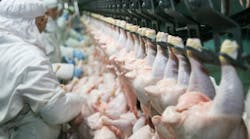I hope I'm not jinxing anybody, but as this second wave of COVID-19 engulfs the nation, and world, one place the disease isn't flourishing is in America's meat and poultry plants.
Meat plants got plenty of bad publicity when the first wave of this pandemic hit. We reported the infections and plant closings for Tyson, JBS, Smithfield and others. And the deaths: 245 as of Nov. 2, according to Food & Environment Reporting Network.
But as this second wave builds steam, and even affects the President, meat and poultry company names are absent from the news. A lot has changed since this pandemic started, with much of the current wave being blamed on students returning to school, the reopening of businesses that draw crowds and the population's general fatigue about this pandemic.
A lot has changed at meat and poultry companies, too, and the hard-learned lessons of the first wave appear to be paying off (fingers crossed).
A spokesman for Cargill told us: "It is too early to say whether or not this wave will have similar impacts as the first or not, but we have learned important lessons from the first wave and continue to learn how to help slow the spread of the virus -- including discussions with local health officials and our employees on reducing community spread, enhancing safety protocols already in place and even undertaking construction at some of our facilities to better allow for social distancing."
I talked to a number of the meat and poultry companies in October, and one point they all made was that first-wave infections in their plants were at worst reflective of the infection rate in the surrounding communities; some claim the in-plant rates were lower.
"We have had some [recent] cases of COVID-19 in our facilities and, with each confirmed case, we immediately enact our pandemic response protocols, work with the local health department and follow strict guidance from the CDC," said a spokesperson for Perdue. Speaking to this second wave, she added, "It is important to note, the positive case rates in all of our facilities have consistently been either at or, in most cases, significantly below the rates of the surrounding area, which means our efforts to protect our associates have been effective."
"Without question, we've been seeing extremely low cases among our employees -- over a sustained period of time, a fraction of 1%," said a spokesperson for Smithfield Foods. He called from his car as he drove between plant locations. "In the past 10 days, I've been in three plants, and I can tell you why: The protective measures in place are incredible."
Smithfield got pretty beaten up by the media in that first wave. Now on their website are a number of bullet points:
- We have not laid off or furloughed any of our more than 42,000 U.S. employees since the pandemic began.
- We have paid employees, approximately 7,000 of them, while shuttering six plants.
- We have offered a paid leave benefit for all employees age 60 or above, not 65, and/or at higher risk for serious complications from COVID-19, as defined by CDC guidelines.
- We have put in place liberal leave and pay policies that have guaranteed pay for nearly 13,000 employees who were quarantined but did not test positive for COVID-19, or were otherwise unable to attain 40 hours of work in a week.
- We have expanded employee health benefits and removed all barriers in our health plan to accessing medical care including eliminating co-pays for COVID-19-related testing and treatment.
- We have hired private healthcare providers, at considerable cost, for every one of our processing facilities to provide free, on-demand COVID-19 testing to all employees. We are encouraging testing despite the sizeable expense.
- We have spent tens of millions of dollars on personal protective equipment (PPE) to include millions of masks and face shields to outfit every single team member, and tens of thousands of sanitizer stations.We have adopted a series of stringent and detailed processes, protocols and protective measures that follow, and in many cases exceed, CDC and OSHA guidance for Meat and Poultry Processing Workers and Employers and CDC and DOL guidance for Agriculture Workers and Employers.
- We donated 40 million servings of protein to food banks nationwide.
All those bullet points probably also apply to the other animal protein companies. And they probably share similar financial news to this Smithfield report: The company suffered a loss of $72 million in the second fiscal quarter of this year, which it attributed to spending $350 million on worker protection and other pandemic-related expenses.
One more note: Last month, Tyson released the recommendations of a blue-ribbon panel, a 10-page report on how workplaces can deal with COVID-19, keeping employees safe and maintaining a reliable food supply.
Working in a meat plant is a tough job, no doubt, but so is the job of supplying animal protein to a nation hungry for both meat and some normalcy at dinner time. The companies are not perfect but it's apparent they're trying very hard and, frankly, no one has figured out this pandemic yet.
